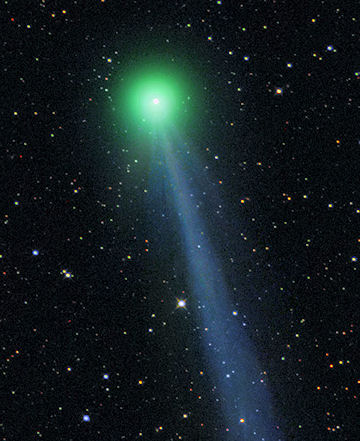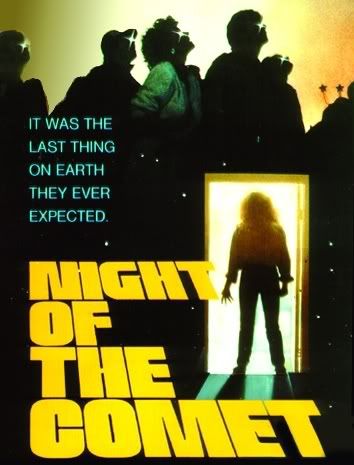
Posted on 06/07/2010 1:05:41 PM PDT by TaraP
COMET McNAUGHT: A fresh comet is swinging through the inner solar system, and it is brightening rapidly as it approaches the sun. Presenting, Comet McNaught (C/2009 R1):
Michael Jäger of Stixendorf, Austria, took the picture on June 6th using an 8-inch telescope. The comet's green atmosphere is larger than the planet Jupiter, while the long willowy ion tail stretches more than a million kilometers through space. These dimensions make the comet a fine target for backyard telescopes.
Comet McNaught can be found low in the northeastern sky before dawn gliding through the constellation Perseus. It is brightening as it approaches Earth for a 1.13 AU close encounter on June 15th and 16th. Currently, the comet is at the threshold of naked eye visibility (5th to 6th magnitude) and could become as bright as the stars of the Big Dipper (2nd magnitude) before the end of the month. Estimates are uncertain, however, because this comet is a newcomer to the inner solar system, and thus somewhat unpredictable. Readers are encouraged to wake up before dawn and monitor developments. 
It’s pretty, but I don’t think anyone, other than the Lord, could get me up before dawn.
May 31st will find McNaught, now hopefully 6th or 7th magnitude, passing 2½° southeast of the 2nd-magnitude star Beta Andromedae. At the beginning of astronomical twilight it’s a respectable 20° up as seen by observers at 40° north latitude. But the waning gibbous Moon will brighten the sky.
The June comet crosses Perseus, low just before dawn, when at its best in June. Click image for larger, printable chart.
Sky & TelescopeOn the morning of June 5th the comet skims just north of the large, loose open cluster NGC 752. On June 6th and 7th it’s within about 2° of the 2nd-magnitude double star Gamma Andromedae. The Moon is much thinner then, but also closer to the comet.
Mid-June is when Comet McNaught should be most interesting, offering the best compromise between its increasing brightness and its decreasing altitude at the start of dawn. Moreover, the sky will be free of moonlight.
The helpful conjunctions continue as the comet passes about 1° north of the open cluster M34 in Perseus on the morning of June 10th, and 3° south of 1.8-magnitude Mirfak (Alpha Persei) on the 13th. It’s still about 15° high in the northeast as the sky starts to grow light on June 15th, but it appears roughly 1° lower every day after that. The comet passes zero-magnitude Capella on the 21st, and it’s very low by the 24th, when it passes 2nd-magnitude Beta Aurigae.
By now Comet McNaught may be as bright as 4th or 5th magnitude, but moonlight is returning.
http://www.skyandtelescope.com/observing/highlights/94277259.html
The comet will be lost to view by June’s end — just before it reaches perihelion on July 2nd, 0.405 astronomical unit from the Sun. It remains far from Earth throughout this apparition, never venturing closer than 1.135 a.u. (in mid-June). After perihelion it will fade rapidly as it heads to the far-southern sky.


Different Comet McNaught. That was C/2006 P1. This one is C/2009 R1.
Right?


Rev: 8 10-11
The third angel blew his trumpet, and(A) a great star fell from heaven, blazing like a torch, and it fell on a third of the rivers and on(B) the springs of water. 11The name of the star is Wormwood.[a] A third of the waters(C) became wormwood, and many people died from the water,(D) because it had been made..
Something to ponder....
How do they know it’s new? Is it still under warranty?.......................
if the comet is streaking through the galaxy... then what is the green stuff IN FRONT of it? wouldn’t the mass of the comet be in the body and moving the fastest? is there some form of gas or some other substance being pushed out ahead of the body of the comet that is diffusing the light?

Comets are always portents of good news. Right?
Unless you owned one............
I know....That is why I thought *Wormwood*
I should have thought of that. Thanks.
It is brightening as it approaches Earth for a 1.13 AU close encounter on June 15th and 16th.
Well..., with it being at a distance of 1.13 AU ... I don't think we'll have to concern ourselves with that one ... in this particular instance ... :-)
Did you see Comet Hale-Bopp back in 1997?

You're used to how things work with atmospheric drag. Since there is no atmosphere in space the results of the ice in the comet sublimating tends to hang around the comet until the solar wind pushes it away from the sun. Anything on the sun's side of the comet will initially move forward of the comet.
When the comet is traveling away from the sun, the tail leads the comet on the way away from the sun. When it is closet to the sun, the tail generally perpendicular to the travel path.
I took this image of M51 about 2 weeks ago...
This is the 'Whirlpool Galaxy' in Canes Venatici. Its companion galaxy, NGC 5195, directly above M51, is an example of interacting galaxies, in this case NGC 5195 is being "ripped apart" by the huge gravitational disturbance of M51.
The distance of M51 is estimated to be about 37 million light years. The diameter is approximately 100,000 light years and the total mass is estimated to be the equivalent of 160 billion suns.

I shot this using a series of 35x120 second exposures, ISO 800, using a Canon 40D, with 6.3 focal reducer, and LP filters in the optical train, all mounted on a 10" SC telescope.
Nice photo!
I tried astro photography for a bit, but, I need better equipment.
I have had some luck with my Digital Video camera on low light setting.
I took some video of Mars and Regulus last night. I hope to get it up to you-tube soon.
I may just have to get up early one day this week and take a peek at this.
Some of my other videos are here:
http://www.youtube.com/watch?v=P-Q4RdU_Tik
http://www.youtube.com/watch?v=bgpEa5onQBo
and
http://www.youtube.com/watch?v=BI-CAbRBiQI
Disclaimer: Opinions posted on Free Republic are those of the individual posters and do not necessarily represent the opinion of Free Republic or its management. All materials posted herein are protected by copyright law and the exemption for fair use of copyrighted works.